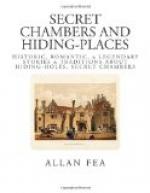Apart, however, from the importance of the secret chamber in fiction, it is closely associated with many an important historical event. The stories of the Gunpowder Plot, Charles II.’s escape from Worcester, the Jacobite risings of 1715 and 1745, and many another stirring episode in the annals of our country, speak of the service it rendered to fugitives in the last extremity of danger. When we inspect the actual walls of these confined spaces that saved the lives of our ancestors, how vividly we can realise the hardships they must have endured; and in wondering at the mingled ingenuity and simplicity of construction, there is also a certain amount of comfort to be derived from drawing a comparison between those troublous and our own more peaceful times.
SECRET CHAMBERS AND HIDING-PLACES
CHAPTER I
A GREAT DEVISER OF “PRIEST’S HOLES”
During the deadly feuds which existed in the Middle Ages, when no man was secure from spies and traitors even within the walls of his own house, it is no matter of wonder that the castles and mansions of the powerful and wealthy were usually provided with some precaution in the event of a sudden surprise—viz. a secret means of concealment or escape that could be used at a moment’s notice; but the majority of secret chambers and hiding-places in our ancient buildings owe their origin to religious persecution, particularly during the reign of Elizabeth, when the most stringent laws and oppressive burdens were inflicted upon all persons who professed the tenets of the Church of Rome.
In the first years of the virgin Queen’s reign all who clung to the older forms of the Catholic faith were mercifully connived at, so long as they solemnised their own religious rites within their private dwelling-houses; but after the Roman Catholic rising in the north and numerous other Popish plots, the utmost severity of the law was enforced, particularly against seminarists, whose chief object was, as was generally believed, to stir up their disciples in England against the Protestant Queen. An Act was passed prohibiting a member of the Church of Rome from celebrating the rites of his religion on pain of forfeiture for the first offence, a year’s imprisonment for the second, and imprisonment for life for the third.[1] All those who refused to take the Oath of Supremacy were called “recusants” and were guilty of high treason. A law was also enacted which provided that if any Papist should convert a Protestant to the Church of Rome, both should suffer death, as for high treason.
[Footnote 1: In December, 1591, a priest was hanged before the door of a house in Gray’s Inn Fields for having there said Mass the month previously.]




